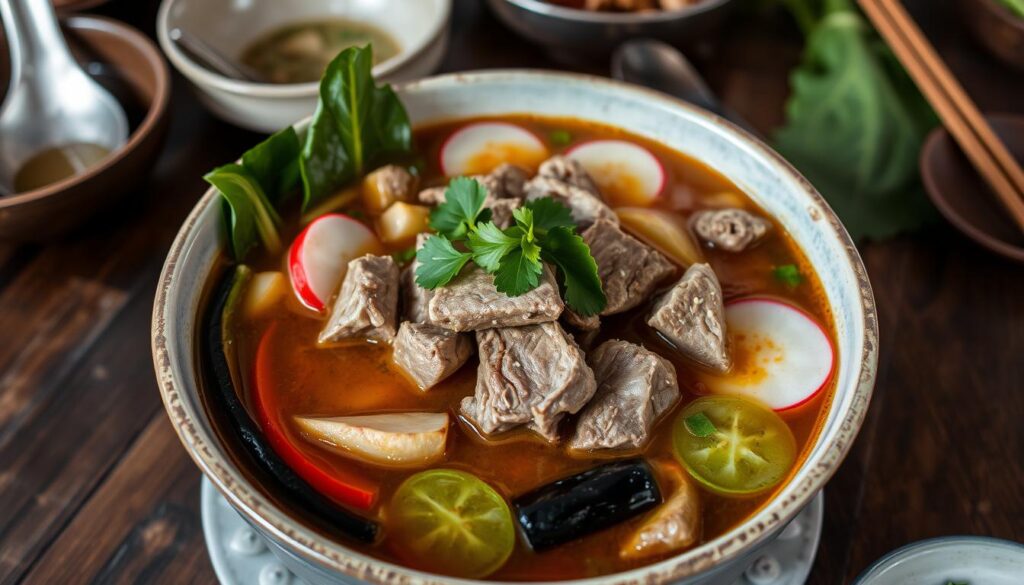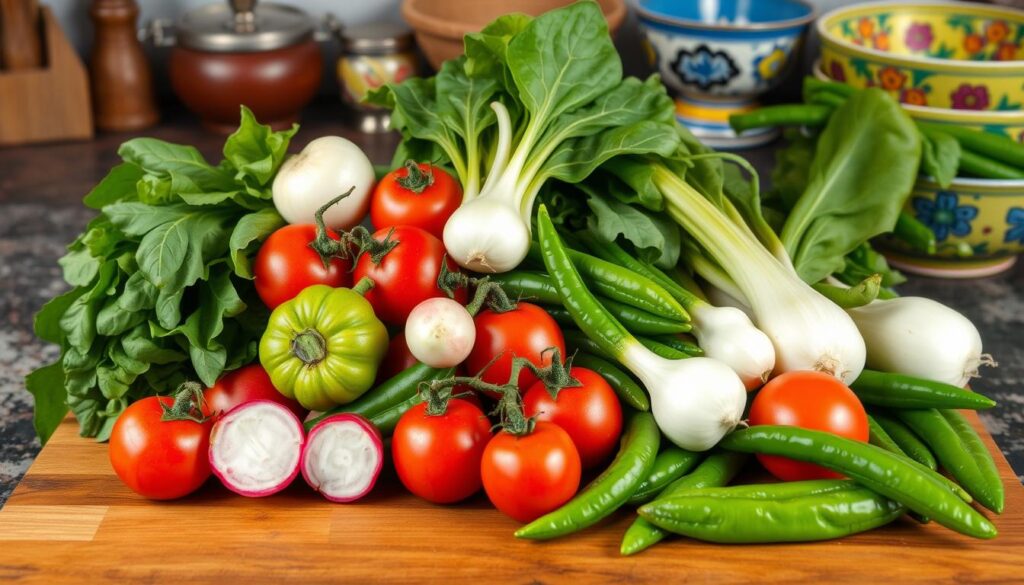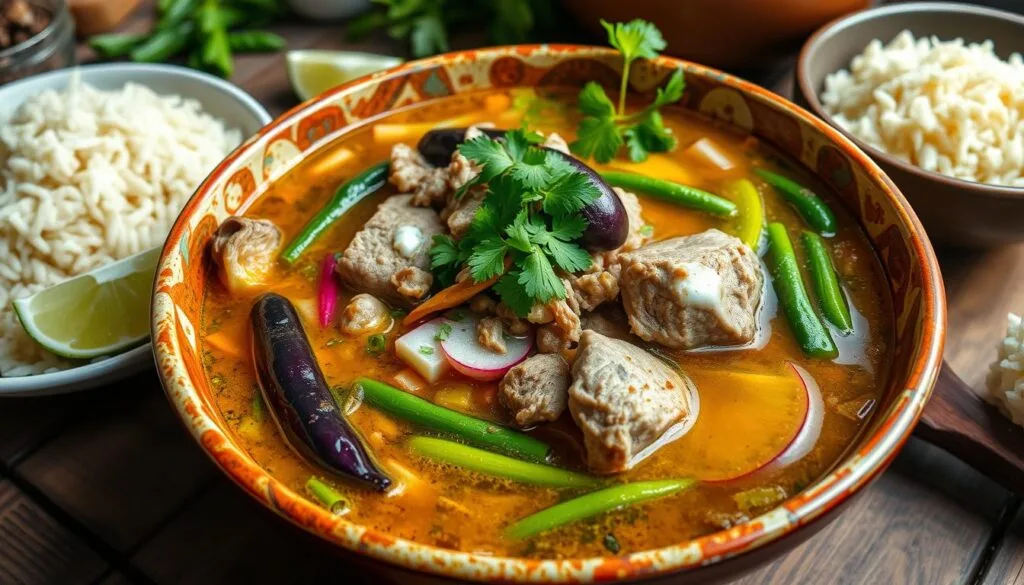Table of Contents
Exploring Filipino cuisine, you’ll find the sinigang recipe. It’s loved for its sour and savory taste. This dish is a favorite in many homes, and you can try it with different proteins and ingredients. This guide will teach you how to make traditional sinigang, so you can enjoy its unique flavors.
To start making sinigang, you need to know its key parts. The ingredients and cooking methods are important for a true Filipino sinigang. As you learn about sinigang, you’ll see how simple yet complex it is.
Introduction to Sinigang
Sinigang is more than a meal; it’s a part of Filipino culture. It’s a dish with deep history and importance in Filipino homes. As you dive into sinigang, you’ll discover its ingredients, cooking ways, and how to serve it.
Key Takeaways
- Understanding the sinigang recipe is essential to creating an authentic Filipino experience.
- The choice of sinigang ingredients plays a crucial role in the dish’s flavor and texture.
- Experimenting with different proteins and vegetables can elevate the sinigang recipe.
- Traditional cooking techniques are essential to capturing the essence of filipino sinigang.
- Presentation and serving styles can enhance the overall sinigang experience.
- Exploring various sinigang ingredients and cooking methods can help you create a unique sinigang recipe.
Understanding Sinigang: The Beloved Filipino Soup
Sinigang is more than a dish; it’s a cultural icon in Filipino cuisine. It has a rich history and plays a big role in Filipino traditions. You can try different versions like filipino beef sinigang and sinigang na baboy, each with its own twist.
To make sinigang, you can use a sinigang mix or start from scratch. Ingredients and cooking methods vary by region. But the heart of sinigang stays the same. It’s perfect for any gathering, big or small.
Historical Origins
Sinigang has been a staple in Filipino cuisine for centuries. Its roots go back to before the Spanish arrived. Over time, it has been shaped by many cultures and traditions.
Cultural Significance
Sinigang is deeply rooted in Filipino culture. It brings people together and creates unforgettable memories. It’s a sign of love, hospitality, and community.
Regional Variations
Every region in the Philippines has its own sinigang style. The north has spicy sinigang na baboy, while the south offers sour filipino beef sinigang. You can try different ingredients and methods to find your favorite. Even using a sinigang mix can make it easier.

Essential Ingredients for Perfect Sinigang
To make a true sinigang recipe, knowing the key ingredients is vital. The right mix of these elements is key to getting the perfect taste. When making sinigang na baboy, using pork ribs is a great choice. They become soft and full of flavor as they cook.
Vegetables like tomatoes, okra, and bok choy add texture and taste. You can pick your favorite veggies or follow local traditions. For sinigang isda, or fish sinigang, choose veggies that match the fish’s light taste. Spinach or mustard greens are good choices.

A souring agent is also needed for sinigang’s unique taste. Tamarind, guava, and other fruits are common choices. You can use fresh or dried fruits, depending on what’s available. The goal is to find the perfect mix of sour and savory.
Here are some key ingredients for your sinigang recipe:
- Pork ribs or other protein sources like fish or shrimp
- A variety of vegetables, such as tomatoes, okra, and bok choy
- A souring agent, like tamarind or guava
- Broth or stock to add moisture and flavor
Understanding the essential ingredients and their roles helps you make a tasty sinigang recipe. Whether you’re making sinigang na baboy or sinigang isda, the secret is to balance the ingredients and flavors. This way, you get a harmonious and savory broth.
Traditional Sinigang Base Preparation
To make a real sinigang dish, like sinigang salmon, you must know its secret. What is sinigang, exactly? It’s a Filipino soup with a unique taste. Is sinigang healthy? Yes, it is, and it’s full of good stuff for your body.
Starting a sinigang base is all about the right steps. First, pick the souring agent for its flavor. Tamarind, calamansi, and guava are top choices. Then, simmer these ingredients to get the best flavors out.
Selecting the Right Souring Agent
The souring agent is key to sinigang’s taste. Here are some favorites:
- Tamarind: The classic choice for sinigang.
- Calamansi: A citrus fruit that adds a special touch.
- Guava: For those who like a sweeter sinigang.
Creating the Broth and Balancing Flavors
After picking your souring agent, make the broth. Simmer it with onions, garlic, and tomatoes. The secret to a great sinigang is finding the right mix of sour, salty, and sweet. With time, you’ll get it just right.
Step-by-Step Classic Pork Sinigang Recipe
To make a delicious sinigang recipe, follow a few simple steps. This traditional filipino food is loved for its sour and savory flavors. The secret to a great pork sinigang is balancing flavors and using quality ingredients.
Here’s what you need to start:
- Pork shoulder or belly, cut into bite-sized pieces
- Tomatoes, onions, and garlic for flavor
- Tamarind broth or sinigang mix for sourness
- Vegetables like spinach, okra, and eggplant
- Salt and pepper for taste
Start by sautéing the pork and onions in a pot. Add tomatoes and garlic next. Then, pour in the tamarind broth and boil. Lower the heat and simmer until the pork is tender.
Finally, add your favorite vegetables and season with salt and pepper.
With these steps, you can make a tasty pork sinigang. This classic filipino food brings the Philippines’ unique flavors to your home. It’s a favorite worldwide, and now you can enjoy it too.
Popular Protein Variations in Sinigang
There’s more to Sinigang than just pork. You can try different proteins for new tastes. Beef sinigang is a hearty choice, using brisket or shank for tender meat.
For something lighter, fish and seafood like sinigang salmon or shrimp are great. They add a fresh taste to the sour broth. If your sinigang is too sour, you can que faire si le sinigang est trop acide and adjust the seasoning.
Chicken sinigang is ideal for those who prefer leaner meat. Use a sinigang mix as a base and adjust cooking time and method. Here are some popular protein options:
- Beef sinigang: use beef brisket or shank for a hearty and flavorful dish
- Fish and seafood options: try sinigang salmon or shrimp for a lighter and fresher take
- Chicken sinigang: a leaner protein source that’s perfect for health-conscious individuals
The secret to great sinigang is balancing flavors and adjusting seasoning. With these protein variations, you can make a sinigang dish that’s both unique and delicious.
| Protein Variation | Cooking Time | Technique |
|---|---|---|
| Beef sinigang | 1-2 hours | Braise the beef in the sinigang broth |
| Fish and seafood options | 10-15 minutes | Add the fish or seafood to the sinigang broth and cook until tender |
| Chicken sinigang | 30-40 minutes | Cook the chicken in the sinigang broth until cooked through |
Vegetable Components and Substitutions
Vegetables are key in Sinigang, adding texture, flavor, and nutrients. You can pick from many traditional veggies like bok choy and mustard greens. Harder veggies like eggplant and okra also work well.
Other Filipino dishes like adobo and pancit can inspire your Sinigang veggies. Bell peppers and carrots, common in adobo, add color and flavor. Lechon’s cabbage and pechay can make your Sinigang crunchier.
Here are some veggie options to consider:
- Leafy greens: bok choy, mustard greens, pechay
- Harder vegetables: eggplant, okra, bell peppers
- Root vegetables: carrots, potatoes, cabbage
Choosing the right veggies for Sinigang is about balance. Try different mixes to find what you like best.
| Vegetable | Flavor | Texture |
|---|---|---|
| Bok choy | Mild, slightly sweet | Crisp, tender |
| Eggplant | Earthly, slightly bitter | Soft, spongy |
| Carrots | Sweet, crunchy | Crisp, firm |
Modern Cooking Methods and Time-Saving Tips
Traditional cooking methods are often preferred for sinigang. But, modern techniques can save time and make it easier to enjoy. You can mix sinigang with chicken adobo for a unique taste.
Using a Sinigang mix can simplify the recipe. It’s great for those new to Filipino cuisine. This way, you can add your favorite protein or veggies easily.
Using Sinigang Mix
A Sinigang mix saves time by eliminating the need to measure ingredients. It’s perfect for busy people who want a tasty sinigang without spending hours cooking.
Pressure Cooker Method
The pressure cooker method cooks sinigang fast. It’s great for those who want a quick, ready meal. You can also use it with other Filipino recipes like chicken adobo.
Slow Cooker Adaptation
A slow cooker makes sinigang easy to cook without much effort. It’s perfect for those who want a ready meal when they come home. You can also mix it with other Filipino dishes like chicken adobo.
Troubleshooting Common Sinigang Challenges
When making sinigang, you might face some challenges. These can include finding the right balance of flavors or dealing with a too sour or salty broth. Understanding how sinigang ingredients work together is key. The type of souring agent used greatly affects the dish’s taste.
Another issue is making sure the protein, like sinigang isda, is cooked just right. You can try changing the cooking time or method. Also, knowing why pourquoi le sinigang est-il populaire aux philippines helps grasp its cultural importance and the need for a good recipe.
Here are some common problems and their fixes:
- Overly sour broth: Cut down on the souring agent or add more water to thin it out.
- Undercooked protein: Cook it longer or use a thermometer to check the internal temperature.
- Imbalanced flavors: Tweak the salt, pepper, or other seasonings to get the flavors right.
By following these tips and understanding the role of sinigang ingredients, you can make a tasty and authentic sinigang. This dish highlights the unique flavors and cultural value of Filipino soup.
Serving and Presentation Techniques
Presenting sinigang is as crucial as its taste. A beautifully set sinigang dish can enhance your dining experience. Serve it with steamed rice, a common choice in Filipino meals.
For a twist, pair sinigang na baboy with fried fish or grilled meats. The goal is to mix flavors and textures well. If using a sinigang mix, adjust the seasoning to your liking.
Traditional Accompaniments
Traditional sides for sinigang include:
- Steamed rice
- Fried fish
- Grilled meats
- Vegetables, such as tomatoes and okra
Rice Pairing Guidelines
Choosing the right rice for sinigang is important. Jasmine rice is a top choice for its scent and texture. Try brown or coconut rice for a different taste.
By using these tips, you can make a stunning sinigang dish. It will impress everyone, whether you’re using a mix or making it from scratch. The most important thing is to have fun and be creative.
Storage and Reheating Guidelines
After cooking sinigang, it’s key to store and reheat it right. This keeps its quality and safety. You can keep it in the fridge for up to three days or freeze it for later. Always heat it to 165°F when reheating to avoid foodborne illness.
This is crucial for sinigang salmon, as fish can easily get contaminated.
Knowing what sinigang is and its cultural value is important. En quoi consiste le sinigang ? It’s a mix of sour and savory flavors. And yes, le sinigang philippin est-il sain ? It is, if stored and reheated correctly.
Proper Storage Methods
- Refrigerate sinigang at a temperature of 40°F or below
- Freeze sinigang at 0°F or below for longer storage
- Use airtight containers to prevent contamination and spoilage
Reheating Best Practices
To reheat sinigang, use the stovetop, microwave, or oven. Heat it to at least 165°F to avoid illness. If it’s too thick, add water or broth.
Conclusion: Mastering Your Sinigang Journey
Mastering sinigang is a rewarding journey that lets you dive into the Philippines’ rich culinary heritage. You’ll learn about its history, cultural importance, and how it varies by region. This helps you appreciate this beloved Filipino comfort food even more.
To make a delicious pork sinigang, choose the right ingredients and balance the flavors. Try different cooking methods to find what works best for you. With the recipes and tips given, you’re ready to impress your loved ones with your cooking skills.
Keep exploring and experimenting with sinigang. Try different proteins and vegetables to make it your own. By staying true to tradition but adding your own twist, you’ll create a sinigang that showcases your culinary talent.
FAQ
What is the basic sinigang recipe?
The basic sinigang recipe includes pork ribs or other proteins. It also has a mix of vegetables like tomatoes, okra, and bok choy. A souring agent, such as tamarind or guava, is used. The goal is to mix sour, salty, and sweet flavors well.
What are the historical origins and cultural significance of sinigang?
Sinigang has been a part of Filipino cuisine for centuries. It dates back to the pre-colonial period. It’s significant because it brings families and communities together, especially during special occasions.
Each region in the Philippines has its own twist on sinigang.
What are the essential ingredients for a perfect sinigang?
For a perfect sinigang, you need a protein source like pork ribs or fish. You also need a variety of vegetables, such as tomatoes, okra, and bok choy. A souring agent, like tamarind or guava, is key. The choice of ingredients depends on personal taste and regional traditions.
How do you prepare the traditional sinigang base?
Preparing the sinigang base is crucial. Choosing the right souring agent is important for its flavor. The broth is made by simmering the souring agent and other ingredients to extract their flavors.
Getting the flavors right is an art. It requires the perfect mix of sour, salty, and sweet.
What are the steps to make a classic pork sinigang?
Making classic pork sinigang involves several steps. First, prepare the ingredients. Then, cook the pork. Finally, assemble the dish.
It’s important to balance the flavors and textures for an authentic taste.
What are some popular protein variations for sinigang?
While pork is traditional, sinigang can also be made with beef, fish, seafood, or chicken. Each protein requires different cooking times and techniques. But the core principles of making sinigang remain the same.
What are the essential vegetable components and substitutions for sinigang?
Traditional vegetables for sinigang include bok choy, mustard greens, eggplant, and okra. You can substitute vegetables based on what’s available and your preference. But remember, different vegetables change the flavor and texture of the dish.
What are some modern cooking methods and time-saving tips for making sinigang?
Modern methods like using a sinigang mix, pressure cooker, or slow cooker can save time. These methods are great for making sinigang quickly. They work well with other Filipino recipes, like chicken adobo.
How can you troubleshoot common sinigang challenges?
Common issues with sinigang include flavor imbalances and over-sour or salty broth. Ensuring the protein is cooked right is also a challenge. This section offers tips to solve these problems, helping you make a delicious sinigang.
How should sinigang be served and presented?
Serving sinigang is an art. It’s best with steamed rice, a staple in Filipino cuisine. Other side dishes like fried fish or grilled meats can also be served. The right rice, like jasmine rice, can enhance the dining experience.
How do you properly store and reheat sinigang?
After cooking sinigang, it’s important to store and reheat it properly. This section provides advice on how to keep sinigang fresh in the fridge or freezer. It also covers the best ways to reheat it without losing flavor or texture.

